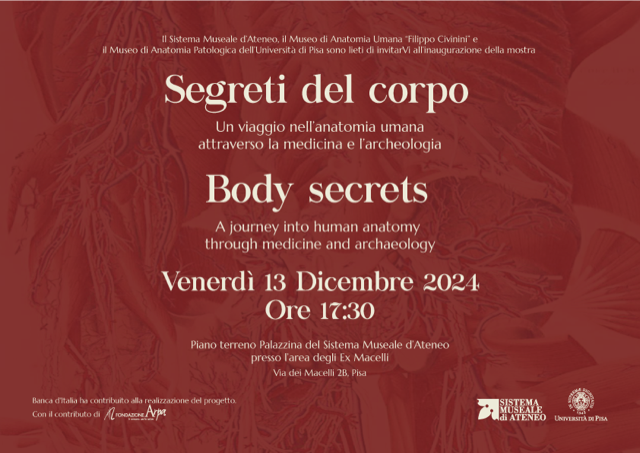Body Secrets. A journey into human anatomy through medicine and archaeology
Museo di Anatomia Patologica e Paleopatologia 13 December 2024
On 13 December 2024 at 5.30 p.m., the exhibition Body Secrets. A journey into human anatomy through medicine and archaeology will be inaugurated at the groundfloor of Sistema Museale di Ateneo building in Via dei Macelli 2B/ Largo Padre Renzo Spadoni – Pisa.
This exhibition offers a journey to discover the human body in its morphological and pathological aspects, from a historical perspective through archaeological finds.
The exhibition includes the following themes:
1. Historical development of studies about the human body through the centuries.
In addition to the reproduction of some anatomical plates by Paolo Mascagni (realized in the early 19th century and representing the human body in life-size), there are dry and wet anatomical preparations and models that introduce human anatomy as a discipline, with a brief narration on its development. The visitor is guided to discover the secrets of the human body, highlighting the role that the city of Pisa played in revolutionising the knowledge of anatomy thanks to the construction of the Anatomical Theatre, commissioned by Cosimo I de’ Medici, in which Vesalius taught the practice of dissecting corpses in 1544.
2. Description of various mummification techniques through archaeological finds.
Another fundamental aspect concerns the topic of the preservation of the body after death, which has accompanied human history for millennia. This section exhibits some mummies, including a pre-Columbian natural mummy, a modern mummy obtained through intra-arterial embalming, and the natural mummy of a child who died of sepsis in the pre-antibiotic era. This section also offers other important archaeological finds, namely the pre-Columbian collection brought from South America by the Pisan surgeon and archaeologist Carlo Regnoli, which also includes grave goods with anthropomorphic vases and some mummified Chilean heads.
3. Display of internal organs and bone specimens, both healthy and affected by various diseases, including archaeological finds from various periods.
Examples of anatomical preparations, both normal and pathological, are exhibited to illustrate the development of human anatomy over time, up to the most recent advances. The exhibition includes foetal skeletons of different ages, preparations illustrating the vascular system, ancient archaeological and forensic bone specimens with pathological evidence, such as tuberculosis and osteochondroma, traumatic lesions, and a skull with trepanation, the oldest surgical operation performed by man. Other preparations include pathological organs in alcohol, such as a lung with anthracosis, a pathology that makes the organ resemble that of a heavy smoker.
For further information, please consult the museums’ websites:
Museum of Human Anatomy “Filippo Civinini”

You must be logged in to post a comment.